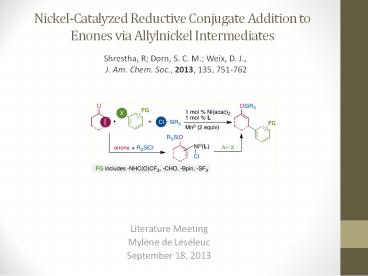Nickel-Catalyzed Reductive Conjugate Addition to Enones via Allylnickel Intermediates - PowerPoint PPT Presentation
1 / 22
Title:
Nickel-Catalyzed Reductive Conjugate Addition to Enones via Allylnickel Intermediates
Description:
Conjugate Addition of Aryl & Vinyl Nucleophiles Importance in synthesis Can be used in the synthesis of prostaglandins1 Can be used in ... (pyridine & thiophene) ... – PowerPoint PPT presentation
Number of Views:170
Avg rating:3.0/5.0
Title: Nickel-Catalyzed Reductive Conjugate Addition to Enones via Allylnickel Intermediates
1
Nickel-Catalyzed Reductive Conjugate Addition to
Enones via Allylnickel Intermediates
Shrestha, R Dorn, S. C. M. Weix, D. J., J. Am.
Chem. Soc., 2013, 135, 751-762
- Literature Meeting
- Mylène de Léséleuc
- September 18, 2013
2
Conjugate Addition of Aryl Vinyl Nucleophiles
- Importance in synthesis
- Can be used in the synthesis of prostaglandins1
- Can be used in the synthesis of steroids2
1Taylor, R. J. K., Synthesis, 1985,
364. 2Horiguchi, Y. Nakamura, E. Kuwajima, I.,
J. Org. Chem., 1986, 51, 4323.
3
Conjugate Addition of Aryl Vinyl Nucleophiles
- Trapping with chlorosilanes for subsequent
regioselective reactions - a-hydroxylation1
- a-amination1
- a-arylation2
1Smith, A. M. R. Hii, K. K., Chem Rev, 2011,
111, 1637. 2Su, W. Raders, S. Verkade, J. G.
Liao, K. Hartwig, J. F., Angew. Chem., Int. Ed.,
2006, 45, 5852.
4
Conjugate Addition with Nucleophilic Aryl Reagants
- Examples
- Rh catalyzed1
- Pd catalyzed2
- No trapping demonstrated
- Good functional group compatibility
1Fagnou, K. Lautens, M., Chem. Rev., 2003, 103,
169. 2Miyaura, N., Synlett, 2009, 2039.
5
Conjugate Addition with Nucleophilic Aryl Reagants
- Strengths of this method
- Good enantioselectivity
- Enolate trapping is possible when Cu or Ni
catalysts are used - Good functional group compatibility when Rh or Pd
catalysts are used - Weaknesses of this method
- Need to preform the organometallic reagants
extra synthetic steps - Enolate trapping has not been demonstrated with
the presence of Rh or Pd catalysts
6
Conjugate Addition with Electrophilic Aryl
Reagants (Reductive Heck Reaction)
- Examples
- Pd catalyzed1
- Co catalyzed2
- Pd electron-rich aryls only
- Co no ß-substitution on enone
1MInatti, A. Zheng, X. Buckwald S. L., J. Org.
Chem., 2007, 72, 9253. 2Amatore, M. Gosmini, C.,
Synlett, 2009, 1073.
7
Conjugate Addition with Electrophilic Aryl
Reagants (Reductive Heck Reaction)
- Strengths
- No preformed organometallic reagants
- Enantioselectivity has been shown with Pd
catalyst - Weaknesses
8
Goal Inspiration
- Combine the mildness of the reductive Heck
reaction with the ability to form silyl enol
ether products - Precedent with allylnickel (II) reagants1
1 Johnson, J. R. Tully, P. S. Mackenzie, P. B.
Sabat, M., J. Am. Chem. Soc., 1991, 113, 6172.
9
Previous Work
- Limited to unactivated alkyl halides
- Tridentate ligand
- Functional group tolerance limited to esters and
nitriles - Mechanism remains nebulous
Shrestha, R. Weix, D. , J. Org. Chem., 2011, 13,
2766.
10
This work
- Includes aryl and vinyl halides
- Wide substrate scope
- Mechanistic study
11
Optimization
- Ligands
- Bidentate ligands show
- best results
- Substitution is important
- Electronics only play a
- small role
12
Optimization
- Silane reagant
- Trimethylsilyl low
- yield
- Large silicon groups
- (TIPS TBDPS) low
- yield
- TESCl, nPr3SiCl
- TBSCl show best
- results
13
Enone Scope
- 5- to 7- membered ring
- enones
- Acyclic enones products
- are formed with modest EZ
- Ratio (21 to 31)
14
Arene Scope electronic effects
- Electron-rich electron-
- poor arenes good yield
- This method is
- complementary to the
- reductive Heck reaction
- which is limited
- to electron-rich aryl halides
- Ortho-substituted aryls
- give lower yields, but could
- be tuned by ligand
15
Arene Scope functional group compatibility
- Bpin is tolerated under these
- Conditions
- Compatible with high
- oxidation-state sulfur
- Compounds
- Compatible with hydrolyzable
- groups (aryl ester trifluoro-
- acetamide)
- limitations found Nitroarene
- heteroarenes (pyridine
- thiophene)
16
Mechanistic Study
- The possible
- pathways
17
Mechanistic Study
- Monitoring MLCT band
- rapid coordination to TESCl enone with TESCl
- slow coordination to iodobenzene and enone
18
Mechanistic Study
- Preparation of two possible intermediates and
their viability
Both solutions are stable for at least 10
minutes. Corresponding dimer products were
observed beyond this time.
19
Mechanistic Study
- Reactions
- with Intermediate IA
- No desired product obtained with the addition of
stochiometric amounts of enone and TESCl - When excess amount of reagants are added, with a
reductant 1st turnover gives biaryl products,
subsequent turnovers give desired product and
enone dimer
20
Mechanistic Study
- Reactions with
- Intermediate IIA
- Low yield when
- PhI is added (stoich.)
- Increased yield when
- Mn is added
- Product obtained when
- TDAE is used instead of Mn
- Reaction with IA and IIA
21
Proposed Catalytic Cycle
- allylnickel intermediates are formed faster than
arylnickel and alkylnickel species - Only the allylnickel intermediates react to form
the desired product - Mechanism by which the allylnickel intermediates
reacts with the phenylhalide is - unknown
22
Conclusion
- New reductive conjugate addition of aryl halides,
vinyl halides and alkyl halide to a,ß-unsaturated
ketones - Superior functional group compatibility than
previous methods - Mechanism is not yet fully understood, but strong
evidence for an enone-first first step

